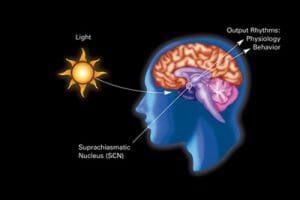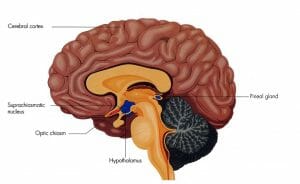Suprachiasmatic Nucleus Definition
The suprachiasmatic nucleus (or just SNC) is a region of the brain within the hypothalamus which uses signals from the eyes to help establish and maintain the biological clock, or circadian rhythm. The hypothalamus is a region of the brain generally associated with the autonomic nervous system which controls unconscious functions such as heart rate, digestion, and pupil dilation. The suprachiasmatic nucleus lies within hypothalamus, and consists of tens of thousands of neurons.
While most of the neurons from the eye extend to the visual cortex in the back of the brain to be processed, some of them go to other places. Some go to the brainstem and cerebellum, which help control reflexed such as eye movement, head position, and controlling the pupils. Other nerves pass through the hypothalamus, and thus through the suprachiasmatic nucleus.
As seen in the image above, the suprachiasmatic nucleus processes signals coming from the eyes and releases hormones and neuronal signals which trigger behavioral and physiological events. This could be everything from lowering the metabolism during certain parts of the day to making the organism more active during other periods. In typical diurnal animals, this means activity when it is warm and sunny and subdued behaviors during the night. This is reversed in nocturnal animals, which use the nighttime to gather food and the daytime to rest. Based on the niche the organism occupies, the exact rhythm could vary greatly.
Where is the Suprachiasmatic Nucleus?
The suprachiasmatic nucleus is located on the ventral side of the hypothalamus, and is really small. It sits on top of the optic chiasm where the optic nerves cross in the middle of the brain. This is significant, as it is a branching point for many optic nerve pathways. In the image below, the suprachiasmatic nucleus can be seen as a small green speck. It sits between the red optic chiasm and the blue hypothalamus.
Function of the Suprachiasmatic Nucleus
The suprachiasmatic nucleus can function in two ways. First, it fires electrical signals at intervals throughout the day. During an organism’s time of peak activity, these signals are being fired off very quickly. When the organism slows and sleeps, the signals are much less frequent. This is thought to stimulate other parts of the brain into action, and may even control the muscle movements of the digestive tract.
Second, this region of the brain can function by releasing hormones and protein products produced by its cells. Like all cells, it is capable of expressing its DNA. Because it is a specialized type of brain tissue, it has the ability to release specific hormones which interact with the body in complex ways. These hormones may influence the activity of other neurons in the brain, which can then electrically stimulate any part of the body. The complexity and intricacy of this system is still not well understood.
Quiz
1. The suprachiasmatic nucleus is part of the hypothalamus, a region of the brain present in all vertebrates. What does this suggest about the evolution of the vertebrate circadian rhythm?
A. Nothing
B. That a circadian rhythm evolved early on
C. That mammals and fish have the same rhythm
2. Which of the following is NOT a way the suprachiasmatic nucleus influences an organism?
A. Through rhythmic impulses
B. By stimulating nerves hormonally
C. Making an organism shiver to build heat
3. Why does it make sense that the suprachiasmatic nucleus relies on light signals?
A. Since the beginning of life on Earth, the sun has been rising and setting at regular intervals
B. Food is always associated with light, so organisms have relied on light to find it
C. Light is perfectly consistent, year round
References
- Feldhamer, G. A., Drickamer, L. C., Vessey, S. H., Merritt, J. F., & Krajewski, C. (2007). Mammology: Adaptation, Diversity, Ecology (3rd ed.). Baltimore: The Johns Hopkins University Press.
- Widmaier, E. P., Raff, H., & Strang, K. T. (2008). Vander’s Human Physiology: The Mechanisms of Body Function (11th ed.). Boston: McGraw-Hill Higher Education.
Suprachiasmatic Nucleus


No comments:
Post a Comment